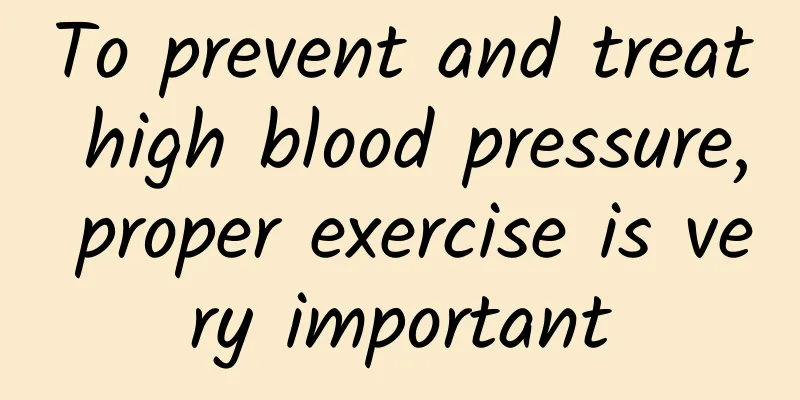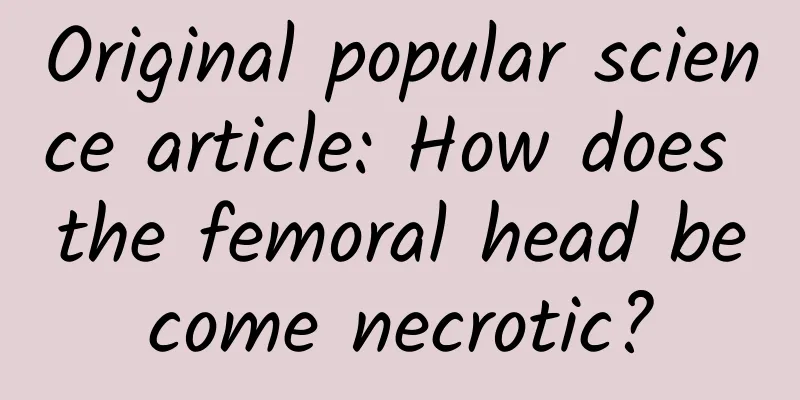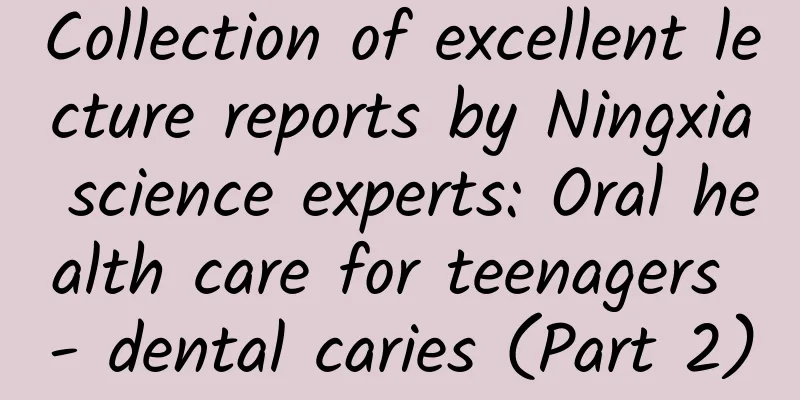To prevent and treat high blood pressure, proper exercise is very important

|
Hypertension is a controllable disease that requires lifelong treatment. A healthy lifestyle, as an important part of hypertension prevention and control, can effectively lower blood pressure or directly reduce the risk of cardiovascular and cerebrovascular diseases. As the saying goes, life lies in exercise. Moderate, appropriate and appropriate exercise will be beneficial to the prevention and treatment of hypertension, but hypertensive patients should not exercise as they please. The "four threes" principle deserves everyone's attention. 1. There are three things to keep in mind when exercising 1. Take some time The "Chinese Hypertension Health Management Standards" states that patients with hypertension can benefit from exercising for 30 minutes or more, 3 days a week or more. Generally speaking, at least 150 minutes of moderate-intensity exercise per week, at least 30 minutes each time, can achieve the best blood pressure-lowering effect. But if you stop exercising, your blood pressure may rise again. 2. Have a certain intensity Moderate or high intensity exercise is recommended. Moderate intensity exercise is the most effective intensity with the most research evidence. Young people can gradually increase the intensity of exercise according to their own situation. We can usually use heart rate reserve (heart rate reserve = maximum heart rate - resting heart rate) to calculate the target heart rate that should be achieved for different intensities of exercise, medium intensity means 40%-59% heart rate reserve or high intensity means 60%-75% heart rate reserve. Target heart rate during exercise = (maximum heart rate - resting heart rate) × exercise intensity + resting heart rate. If a 50-year-old hypertensive patient plans to do moderate intensity exercise, assuming that the exercise intensity is 50%, and his maximum heart rate has been measured to be 170 beats/minute and his resting heart rate is 80 beats/minute, then his target heart rate during exercise = (170-80) × 50% + 80 = 125 beats/minute. Of course, we can also judge the intensity of exercise based on our own feelings: compared with the resting state, breathing and heart rate are slightly faster, there is slight panting, and one can talk but not sing, which basically reaches moderate exercise intensity; breathing and heartbeat are obviously faster, there is shortness of breath, and one cannot speak coherently, which basically reaches a higher exercise intensity. 3. Have the right form 3.1 Aerobic training Aerobic exercise refers to physical exercise performed by the human body with sufficient oxygen supply. Aerobic exercise can lower blood pressure by enhancing cardiopulmonary function and reducing sympathetic nerve excitability. Common aerobic exercises include brisk walking, jogging, swimming, Tai Chi, Ba Duan Jin, Wu Qin Xi, etc. Among them, Tai Chi and Ba Duan Jin can also adjust the breath and mind to achieve the effect of harmonizing qi and blood and treating both body and mind, and are a good choice for daily exercise for patients with hypertension. 3.2 Resistance training Resistance training mainly refers to anaerobic exercise, which is a kind of exercise against resistance. Common exercises such as squats, pull-ups, push-ups, bench presses, and high jumps are all resistance training. Impedance training can have a positive effect on blood pressure by enhancing muscle strength and improving the body's metabolic capacity. The 2020 European Society of Cardiology Guidelines pointed out that appropriate light to moderate resistance exercise can reduce the activity of the vagus nerve in patients with hypertension, downregulate the sensitivity of the peripheral sympathetic nerves, and achieve the effect of reducing vascular resistance and assisting in lowering blood pressure. Static resistance training is a type of resistance training, also known as isometric training, which refers to training in which muscles contract against resistance but do not move joints, only maintaining a fixed posture, such as squatting against a wall, plank support, and horse stance. It is an ideal exercise for middle-aged and elderly people with limited mobility. A recent study published in the British Journal of Sports Medicine pointed out that isometric training can reduce blood pressure by 8.24/4mmhg after exercise, with a significant blood pressure-lowering effect. It is recommended to arrange resistance training 3 days a week, with a training intensity of 50%-80% 1-RM (1-RM training: represents the maximum weight a person can lift at one time), 6 exercises/group, 3 sets, and 10 repetitions. 3.3 Neuromuscular training Neuromuscular training, also known as neuromuscular control exercises, is a comprehensive training method that aims to enhance the coordination and function between nerves and muscles through specific movements and exercises. This training method not only focuses on muscle strength and endurance, but also pays attention to the reaction speed and accuracy of the nervous system, including exercises of control skills such as balance, coordination, gait and proprioception, such as standing on one leg with eyes closed, dancing, etc. 2. Three things to do after practice 1. Relax well You should stretch promptly after exercise to slow down the accelerated blood circulation. You should stretch for at least 10 minutes. The stretching time can be extended as appropriate for the elderly or those who exercise at a higher intensity. 2. Eat well Eat a reasonable diet and balanced nutrition; eat in moderation and eat until you are 80% full; eat less raw, cold, greasy and other foods that may hinder the functioning of the spleen and stomach; avoid stimulating drinks such as coffee and strong tea after exercise, and drink warm water in moderation. 3. Sleep well After exercise, you should rest and sleep enough. You can check whether the exercise is reasonable and whether it needs to be adjusted by the following three aspects after waking up: Morning pulse is not high: the heart rate at rest is not higher than usual when you get up the next day; No pain in the whole body: There is no obvious pain and stiffness in muscles and joints after getting up; No bad spirit: No fatigue after getting up, full of energy and refreshed. 3. Remember the three no's 1. The following people with high blood pressure should not exercise. Exercise can achieve a good blood pressure-lowering effect, but not all people with high blood pressure are suitable for exercise. Hypertensive patients with hypertensive emergencies, hypertensive crises, severe hypertension, poor blood pressure control, and those with a sharp increase in blood pressure during exercise are not suitable for exercise. Exercise also needs to be conducted under the guidance of a professional doctor. 2. Stop exercising if the following conditions occur during exercise: pain and pressure in the chest, back, shoulders or arms; pale face, sweating, dizziness, nausea; muscle cramps, acute pain in joints, ankles and leg muscles; severe fatigue, severe lower limb pain or intermittent claudication; severe dyspnea, cyanosis; during exercise test, systolic blood pressure ≥ 250 mmHg and/or diastolic blood pressure ≥ 115 mmHg or systolic blood pressure drops by > 10 mmHg when the load increases. 3. Avoid unhealthy exercise habits. Do not hold your breath, spin quickly, exert force suddenly, or lower your head too deeply during exercise. 4. Three Principles of Traditional Chinese Medicine 1. Slight sweating is recommended Yang is the basis of life. Exercise can raise Yang. When Yang is raised, vitality is naturally strong. However, excessive exercise will consume Yang, which is the basis of life, and will damage health. It is recommended to exercise until you sweat slightly, and not sweat heavily to hurt Yang. 2. Follow the four seasons Exercise should follow the rules of spring growth, summer growth, autumn harvest, winter storage and the changes of day and night. For example, in spring and summer, the yang energy rises, and the human body can follow the rise of the yang energy and appropriately increase the amount of outdoor exercise, while in autumn and winter, the yang energy is hidden, so it is not suitable to exercise a lot. On sunny days, you can go to the park to bask in the sun, take a walk, practice Tai Chi, etc. In addition, the daytime is yang, and the human body's yang energy runs outside, so you can move normally; the night is yin, and the yang energy runs inside, and it needs to be hidden to be nourished, so the amount of exercise should be reduced. 3. Combining static and dynamic Combining movement and stillness is the core concept of TCM exercise health preservation. Movement nourishes the body, and physical activities can promote the smooth flow of qi and blood; stillness nourishes the mind, and keeping the mind pure and peaceful can keep the mind hidden and the body healthy. During exercise, breathing, regulating qi, and calming the mind can achieve the purpose of combining movement and stillness and nourishing both the body and the mind. The above are the details that patients with hypertension should pay attention to during exercise. We hope that through our popular science, patients with hypertension can understand the scientific and healthy way of exercise, and achieve the goal of stabilizing blood pressure and promoting healthy living by adjusting their lifestyle and exercising regularly and effectively. Source: Bai Ruina and Gao Zhuye, members of the Science Popularization Studio of Shi Dazhuo, a famous doctor of the Chinese Association of Traditional Chinese Medicine Reviewer: Shi Dazhuo, Director of the Science Popularization Studio of Famous Doctors and Experts of the Chinese Association of Traditional Chinese Medicine, Researcher of Xiyuan Hospital of China Academy of Chinese Medical Sciences About the Author Bai Ruina, Doctor of Medicine, Associate Chief Physician, Master Supervisor, Associate Professor of Beijing University of Chinese Medicine, and the seventh batch of national senior Chinese medicine experts and academic experience inheritors. She is good at the diagnosis and treatment of cardiovascular diseases such as post-interventional coronary heart disease, heart failure, myocardial infarction, hypertension, cardiac neurosis, hyperlipidemia, etc. with the combination of Chinese and Western medicine and rehabilitation treatment. She is also a member of the Cardiovascular Disease Professional Committee of the World Federation of Chinese Medicine, a young member of the Cardiovascular Disease Branch of the Chinese Association of Traditional Chinese Medicine, etc. She was selected into the Excellent Young Science and Technology Talent Project of the China Academy of Chinese Medical Sciences and the Clinical Teaching Talent Project of Xiyuan Hospital. She presided over 8 projects including the National Natural Science Foundation, and published more than 20 academic papers as the first author or corresponding author. Gao Zhuye, Doctor of Medicine, Chief Physician, Professor, Doctoral Supervisor, Young Qihuang Scholar, National Key Talent in TCM Innovation, and was awarded the title of "Young TCM Truth Seeking Scholar" by the Chinese Association of Traditional Chinese Medicine. He is the Director of the Education Department of Xiyuan Hospital, China Academy of Chinese Medical Sciences, and the Deputy Director of Suzhou Hospital, Xiyuan Hospital, China Academy of Chinese Medical Sciences. He has been engaged in the prevention and treatment of cardiovascular diseases with integrated Chinese and Western medicine for a long time, and is good at the diagnosis and treatment of coronary heart disease, hypertension, heart failure, dual heart disease, atrial fibrillation and other diseases with integrated Chinese and Western medicine. He also serves as the Secretary-General of the Professional Committee of Activating Blood Circulation and Removing Stasis of the Chinese Association of Integrated Traditional Chinese and Western Medicine; he has visited and exchanged with the National Natural Science Foundation of China, and served as the Director of the Mobile Compilation Project of TCM Disciplines. He has presided over and participated in 21 projects such as the National Major New Drug Creation Project and the National Natural Science Foundation Project; published more than 170 papers in core journals at home and abroad, 37 of which were included in SCI; obtained 2 national invention patents; participated in the writing of 6 books; and won 9 provincial and ministerial awards such as the Second Prize of the National Science and Technology Progress Award. Audit Expert Profile Shi Dazhuo, Chief Researcher of China Academy of Chinese Medical Sciences, Qihuang Scholar, Famous TCM Doctor of the Capital, Professor of Peking University School of Medicine, Professor of Beijing University of Chinese Medicine, Doctoral Supervisor of China Academy of Chinese Medical Sciences, Head of the Science Popularization Studio of Famous Doctors and Experts of China Association of Chinese Medicine. Academic leader of Internal Medicine and Cardiovascular Disease of China Academy of Chinese Medical Sciences, Director of the Institute of Cardiovascular Disease of China Academy of Chinese Medical Sciences, Director of the Key Specialty of Cardiovascular Disease of TCM of the Ministry of Health, Executive Deputy Director of the National Research Center of Cardiovascular Disease of TCM, Member of the National Pharmacopoeia Committee, and the sixth and seventh national TCM teacher. He is also the Chairman of the Cardiovascular Disease Professional Committee of the World Federation of Chinese Medicine, Honorary Chairman of the Professional Committee of Blood Activation and Stasis Removal of Integrated Traditional Chinese and Western Medicine of China, Deputy Editor-in-Chief of Frontiers in Pharmacology, Deputy Editor-in-Chief of "Chinese Journal of Integrated Traditional Chinese and Western Medicine", Deputy Editor-in-Chief of "Global TCM", Editorial Board Member of "Chinese Journal of Cardiovascular Diseases", etc. He has successively won the honorary titles of National Young and Middle-aged Science and Technology Star, National Advanced Worker of Integrated Traditional Chinese and Western Medicine, and Expert with Outstanding Contributions of the Ministry of Health. Mainly focuses on the combination of Chinese and Western medicine in the treatment of cardiovascular diseases (post-interventional coronary heart disease, heart failure, myocardial infarction, hypertension, etc.) and rheumatoid arthritis, ankylosing spondylitis, etc. |
<<: Summer delicacy top trend causes "Haff disease"? Crayfish says: I won't take the blame!
Recommend
What is a 10x magnifying glass? What is the function of a magnifying glass?
A magnifying glass is an instrument that can be u...
What is this small lump next to my chest?
We all know that going to the hospital to see a d...
Is there menopause after menopause?
When female friends reach a certain age, they wil...
What information do I need to apply for a mortgage? How do I calculate the repayment of a mortgage?
Buying a house is a big event in life. Many peopl...
Yellow-green purulent discharge
Women's health is very important. Many women ...
What is the best way to reduce sagging breasts?
Many women have great figures and are very satisf...
When does a girl's second menstrual period come after menarche?
The first menstrual period marks the beginning of...
What to do if a pregnant woman catches a cold and has diarrhea
Pregnant women need to be taken good care of in t...
How to quickly excrete after taking miso
Misoprodol is a drug for inducing labor, and it w...
What causes delayed menstruation?
Many women will experience delayed menstruation d...
What is the pain in the lower right side of the lower abdomen?
Female friends are very prone to abdominal pain, ...
Schematic diagram of uterus structure
The uterus is a unique organ of women. It is the ...
Routine examination before amniocentesis
Amniocentesis is a common method of examination. ...
Papanicolaou secondary squamous cell inflammatory changes
Cells are the basic substances that make up the b...









